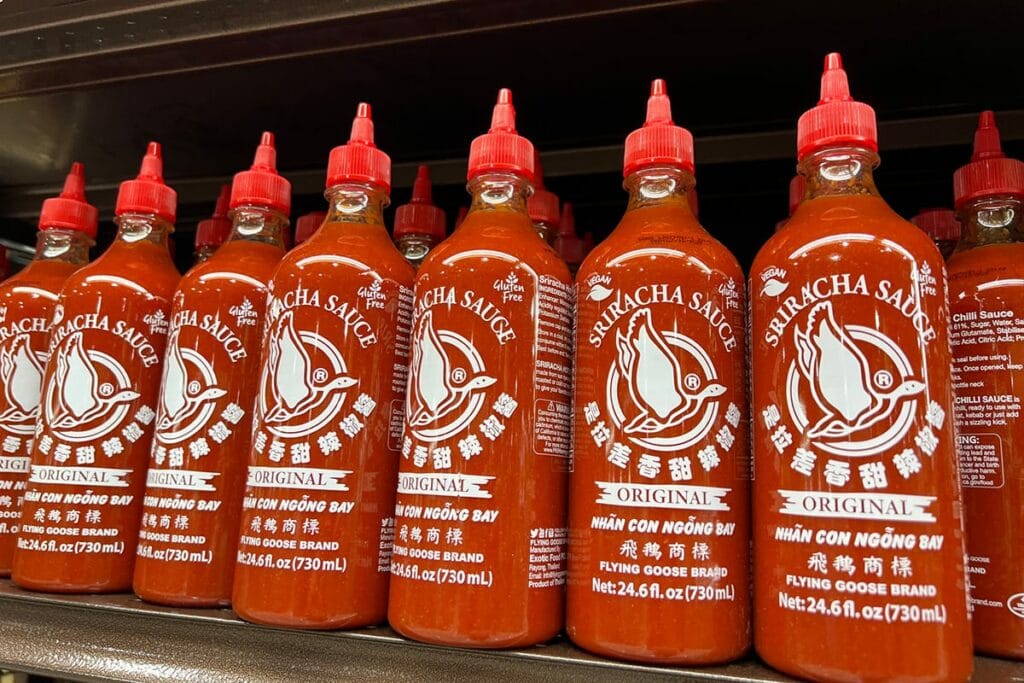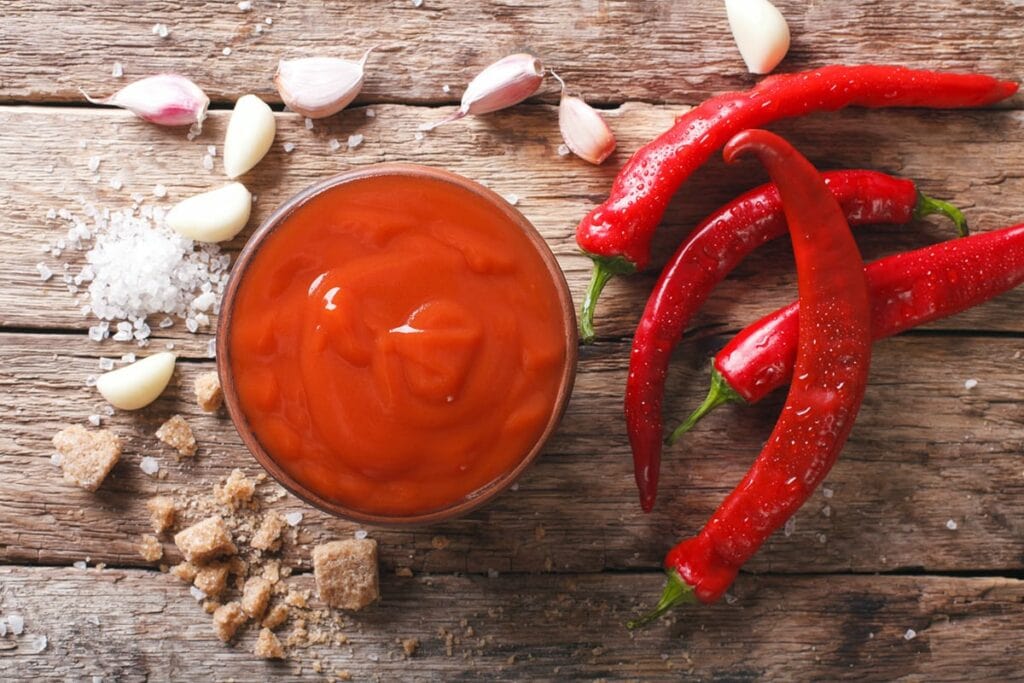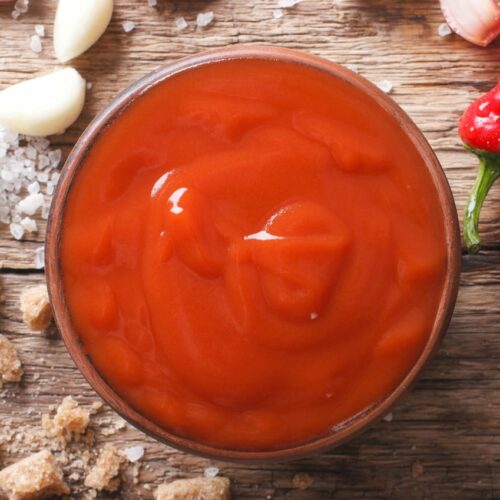In this ingredient guide, I am exploring all things Sriracha: what it is, its key ingredients, how to use it and how to make this popular Asian hot sauce in your kitchen.

Jump to: What It Is | 🌶Key Ingredients | 👅 Taste Profile | 🧐 Shortage | 🔄 Substitutes | 👩🍳 How To Use It |📝Homemade Recipe | 💡 Variations
What Is Sriracha?
Sriracha – pronounced si-rah-chah – is a hot sauce that has its origins in Thailand where a woman called Thanom Chakkapak from the town of Si Racha developed the recipe.
Her version is known to be more Tobasco-esque which is rather thin and vinegary. Over the next fifty years, this recipe probably travelled through Asia with many adaptations. Then, a Vietnamese man called David Tran immigrated to the U.S. and started making what we know as sriracha – thick, spicy, and sweet. He even named his sauce after the ship that he travelled on: Huy Fong – the iconic brand name many of us know and love today.
Sriracha or “rooster sauce” has been a household staple since the 1980s.
Sriracha Ingredients
The spicy magic begins with a base of chilis like any good hot sauce. Sriracha also contains vinegar, pickled garlic, sugar, and salt. Sriracha stands on its own when it comes to hot sauces because of its texture. It’s much more similar in texture to ketchup or cocktail sauce than it is buffalo sauce, for example.

What Does Sriracha Taste Like?
Sriracha is spicy, but it’s not extra spicy. It’s probably best categorised into the mild tier for chili-based sauces, but to each their own. Some folks have a lower or higher tolerance for spicy foods than others.
Beyond the initial bite, it’s pretty sweet. Of all the hot sauces you might be familiar with, sriracha has one of the highest sugar content. Finally, it’s notably pungent. It tastes a bit fermented which gives it an excellent kick and makes it particularly delicious in Asian cuisine.
Where To Get Sriracha?
While in the past, you’d have to venture to your local Asian grocer to buy Sriracha sauce, these days it’s usually available from most major supermarkets and online, of course. It’s one of the easier Asian sauces to find.
Sriracha Shortage: What Happened?
Over the past few years, people have been missing their favourite hot sauce on shelves, in the US specifically. The culprit? A chili shortage!
Mass production of any product relies on a steady supply of the main ingredient, so drought conditions in Mexico – where Huy Fong sources their peppers – had global reach. The years-long shortage put Huy Fong’s reputation on the line. All the while, many other brands began producing their take on sriracha, and many consumers probably didn’t notice the shortage. Most sriracha dupes even come in a similarly shaped bottle.
When will the Sriracha shortage end? The shortage may be coming to an end with new suppliers, but the comeback to shelves for Sriracha has been slow so you may still struggle to find Huy Fong at your regular grocery store. Moreover, Huy Fong likely sourced additional growers for chilis which may lead to differences in taste before they re-master their traditional recipe. Thankfully, there are many store-bought and homemade alternatives.
Substitutes For Sriracha
With so many spicy condiments and hot sauces on shelves, there are plenty of substitutes for Sriracha. However, some products and recipes will work better than others. Sauces with a little added sugar and a thicker consistency will work best in its place. Garlic chilli sauce, sweet chili sauce, Sambal Oelek, and gochujang are some of my favourite suggestions for alternatives.
Does Sriracha Need To Be Refrigerated?
Like many hot sauces and condiments, a cool dry place goes a long way in terms of storage. Sriracha can easily be kept in the pantry, even after the bottle is open.
Using Sriracha
Sriracha sauce, with its spicy, garlicky, and slightly sweet flavour is incredibly versatile. You can use it any time you want to add a lively kick to a dish. Some ideas include for using it:
- in marinades for animal protein, shrimp and tofu.
- as a condiment over burgers, hot dogs, sandwiches, tacos or nachos
- add to soups and stews for extra chili and umami
- add spiciness and extra flavour to your stir-fry sauce.
- drizzle over fried egg or boiled eggs
- as a dipping sauce for spring rolls, dumplings or chicken wings; you can mix Sriracha with soy sauce, lime juice and a bit of honey for a nice sauce.
- spice up the cocktails like Bloody Mary or even Margarita.
- Check out these delicious recipes using Sriracha sauce

Want to Save This Recipe?
Enter your email & I’ll send it to your inbox. Plus, get great new recipes from me every week!
By submitting this form, you consent to receive emails from Cooked & Loved

Making homemade Sriracha sauce involves a few simple steps. Here’s a straightforward recipe you can follow at home.
-
Blend: In a blender, combine the red jalapeño peppers, garlic cloves, brown sugar, and kosher salt. Blend until a smooth paste forms.
-
Ferment: Transfer the mixture to a clean jar, leaving a tiny bit of space at the top for expansion. Cover the jar tightly with a lid. Let the mixture ferment at room temperature, away from direct sunlight, for around 5 days. Check after 24-36 hours (24 if warm, 36 if cooler). There should be a little popping sound when you open the jar, indicating gas bubbles are present. Using a very clean spoon, stir once you see any fermentation bubbles. Close the lid and continue fermenting for 36-48 more hours, then check again. The fermentation can take anywhere between 5 days and 10 days, depending on room temperature.
-
Cook: After fermentation, transfer the mixture to a saucepan. Add the distilled white vinegar and bring to a boil. Lower the heat and simmer for 5 to 10 minutes, allowing the flavours to meld.
-
Blend again: Let the mixture cool slightly, then blend again until smooth. If the sauce is too thick, you can add water to reach your desired consistency.
-
Strain: Strain the sauce through a fine mesh strainer into a bowl, pressing to extract as much liquid as possible. Discard the solids.
-
Bottle and store: Transfer the strained sauce into a clean bottle or jar. Store in the refrigerator. The sauce will keep for up to 6 months, often becoming more flavourful as it ages.
Feel free to adjust the amount of sugar, salt, and vinegar to taste. The fermentation step is crucial for developing the sauce’s unique flavour, but ensure to monitor it to avoid any unwanted mould growth.
Calories: 85kcal | Carbohydrates: 20g | Protein: 0.4g | Fat: 0.03g | Saturated Fat: 0.01g | Polyunsaturated Fat: 0.01g | Sodium: 3495mg | Potassium: 50mg | Fiber: 0.1g | Sugar: 18g | Vitamin A: 1IU | Vitamin C: 2mg | Calcium: 31mg | Iron: 0.3mg
Sriracha Variations
The popularity of Sriracha sauce has of course led to the creation of sauce variations. You can find many of these as store-bought sauces and they are also easy to make at home.
- Honey Sriracha sauce: Mix 1/4 cup Sriracha sauce with 1 tablespoon honey for a sweetened version that’s great on chicken wings or grilled prawns.
- Sriracha mayo – Mix 1/4 cup mayonnaise with 1 tablespoon of Sriracha for a spicy, flavourful mayo sauce that can be used on tacos, as a dip for chicken nuggets, or as a drizzle on a poke bowl. It’s a sauce to go with my prawn fritters.
- Sriracha ranch – Simply add a tablespoon of hot stuff to your regular ranch dressing to give it that lovely fermented chili and garlic taste and a little spice kick. Use as you would regular ranch.
- Sriracha ketchup – like a regular ketchup but for grown-ups, simply combine both at whatever ratio you like.

